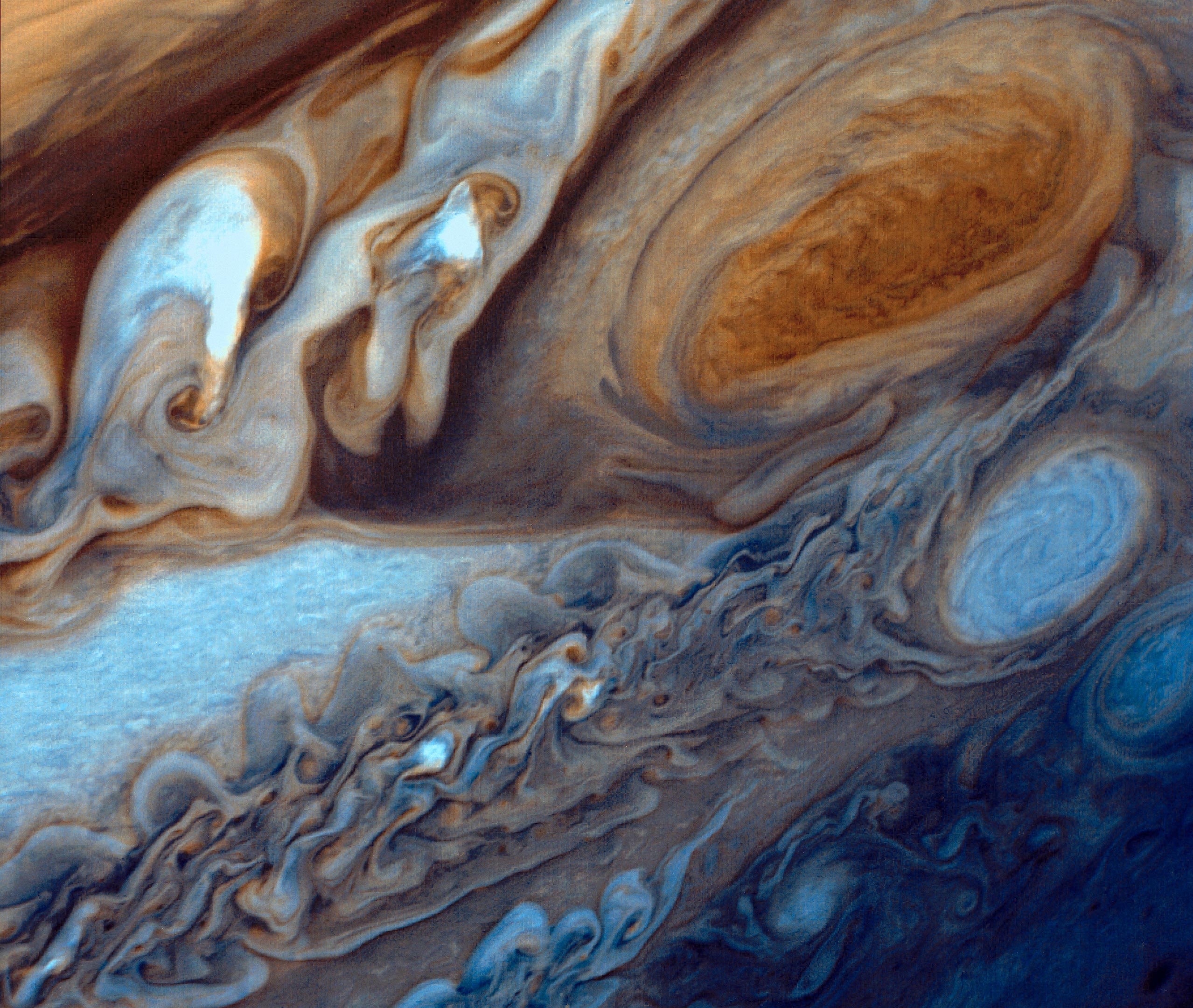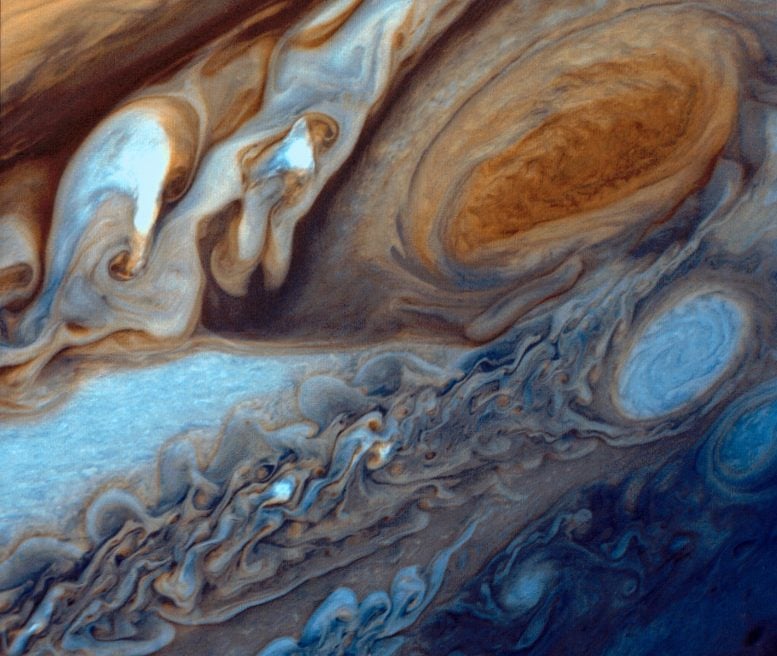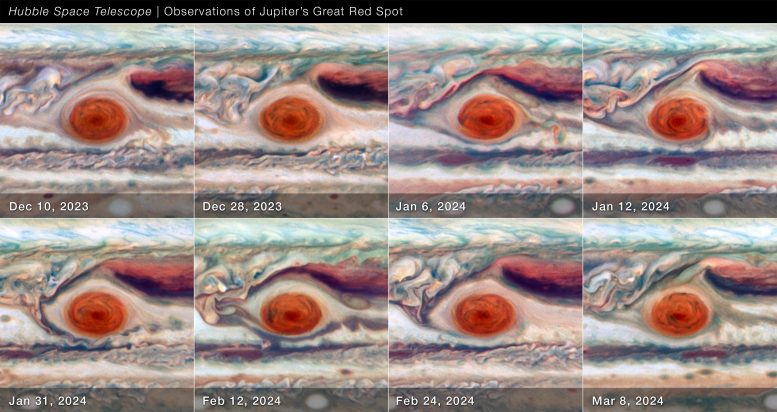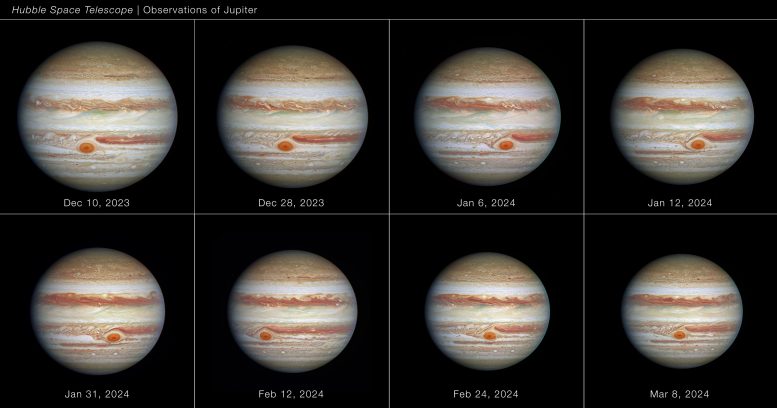

Jupiter’s Titanic Storm Wiggles Like a Plate of Gelatin
Jupiter’s birthmark is an unbelievably huge storm that’s mysteriously crimson red in color. It looks like a bloodshot cycloptic eye staring back at Earth. The anticyclone churns along a southern mid-latitude cloud belt and has survived in Jupiter’s turbulent atmosphere for at least 150 years. What’s mind-numbing is that the Great Red Spot (GRS) is big enough to swallow our entire planet, making it the largest storm in the solar system.
Astronomers need Hubble’s keen vision to keep an eye on the GRS’s behavior, like a weatherman watching a spinning hurricane. This is done only once per year under the Outer Planet Atmospheres Legacy program (OPAL), but a new program has enabled Hubble to capture eight views of the spot over a 90-day period. And there are always new surprises.
For 90 days between December 2023 and March 2024, a collection of Hubble photos reveal that the GRS is not as stable as it might look. Its elliptical shape can change dimensions – looking like a slightly skinnier or fatter red oval. This shape-shifting is unexpected and unexplained. But in hindsight, this might not be a total surprise considering that Jupiter’s atmosphere is ever-changing with dynamic winds. It’s like trying to predict the exact motion of a swirl of creamer poured into a cup of coffee. Does the meteorology on giant planets around other stars have their own immense storms? Hubble’s detailed look at Jupiter might offer new clues.

Hubble Space Telescope Watches Jupiter’s Great Red Spot Behave Like a Stress Ball
Astronomers have been observing Jupiter’s legendary Great Red Spot (GRS), an anticyclone large enough to engulf Earth, for over 150 years. Yet, the spot continues to unveil new surprises, particularly when observed up close by NASA’s Hubble Space Telescope.
Recent observations by Hubble, conducted over a 90-day period from December 2023 to March 2024, have revealed that the GRS is not as stable as previously thought. The data show the GRS oscillating like a bowl of gelatin. These observations allowed astronomers to compile a time-lapse movie showcasing the erratic behavior of the GRS.
This time-lapse movie is assembled from Hubble Space Telescope observations spanning approximately 90 days (between December 2023 and March 2024) when the giant planet Jupiter ranged from 391 million to 512 million miles from the Sun.
Surprising Size Oscillations
“While we knew its motion varies slightly in its longitude, we didn’t expect to see the size oscillate as well. As far as we know, it’s not been identified before,” said Amy Simon of NASA’s Goddard Space Flight Center in Greenbelt, Maryland, lead author of the science paper published in The Planetary Science Journal. “This is really the first time we’ve had the proper imaging cadence of the GRS. With Hubble’s high resolution we can say that the GRS is definitively squeezing in and out at the same time as it moves faster and slower. That was very unexpected, and at present there are no hydrodynamic explanations.”
Hubble monitors Jupiter and the other outer solar system planets every year through the Outer Planet Atmospheres Legacy program (OPAL) led by Simon, but these observations were from a program dedicated to the GRS. Understanding the mechanisms of the largest storms in the solar system puts the theory of hurricanes on Earth into a broader cosmic context, which might be applied to better understanding the meteorology on planets around other stars.
Simon’s team used Hubble to zoom in on the GRS for a detailed look at its size, shape, and any subtle color changes. “When we look closely, we see a lot of things are changing from day to day,” said Simon. This includes ultraviolet-light observations showing that the distinct core of the storm gets brightest when the GRS is at its largest size in its oscillation cycle. This indicates less haze absorption in the upper atmosphere.
This animated diagram shows the position of Earth relative to Jupiter during a period spanning approximately 90 days (between December 2023 and March 2024) when the giant planet Jupiter ranged from 391 million to 512 million miles from the Sun.
Comparative Planetology and Future Predictions
“As it accelerates and decelerates, the GRS is pushing against the windy jet streams to the north and south of it,” said co-investigator Mike Wong of the University of California at Berkeley. “It’s similar to a sandwich where the slices of bread are forced to bulge out when there’s too much filling in the middle.” Wong contrasted this to Neptune, where dark spots can drift wildly in latitude without strong jet streams to hold them in place. Jupiter’s Great Red Spot has been held at a southern latitude, trapped between the jet streams, for the extent of Earth-bound telescopic observations.
The team has continued watching the GRS shrink since the OPAL program began 10 years ago. They predict it will keep shrinking before taking on a stable, less-elongated, shape. “Right now it’s over-filling its latitude band relative to the wind field. Once it shrinks inside that band the winds will really be holding it in place,” said Simon. The team predicts that the GRS will probably stabilize in size, but for now Hubble only observed it for one oscillation cycle.

Anticipating Further Insights
The researchers hope that in the future other high-resolution images from Hubble might identify other Jovian parameters that indicate the underlying cause of the oscillation.
Reference: “A Detailed Study of Jupiter’s Great Red Spot over a 90-day Oscillation Cycle” by Amy A. Simon, Michael H. Wong, Phillip S. Marcus and Patrick G. J. Irwin, 9 October 2024, The Planetary Science Journal.
DOI: 10.3847/PSJ/ad71d1
The results are being presented at the 56th annual meeting of the American Astronomical Society Division for Planetary Sciences, in Boise, Idaho.
The Hubble Space Telescope has been operating for over three decades and continues to make ground-breaking discoveries that shape our fundamental understanding of the universe. Hubble is a project of international cooperation between NASA and ESA (European Space Agency). NASA’s Goddard Space Flight Center in Greenbelt, Maryland, manages the telescope and mission operations. Lockheed Martin Space, based in Denver, Colorado, also supports mission operations at Goddard. The Space Telescope Science Institute in Baltimore, Maryland, which is operated by the Association of Universities for Research in Astronomy, conducts Hubble science operations for NASA.